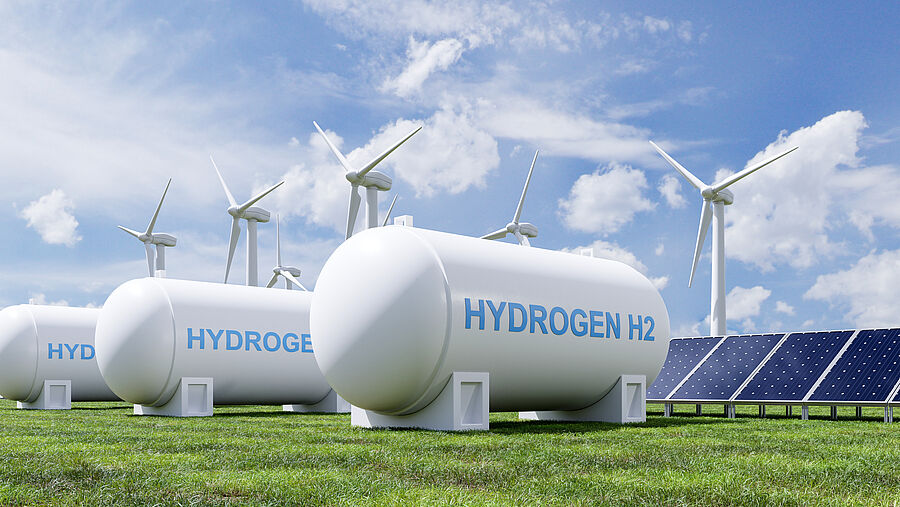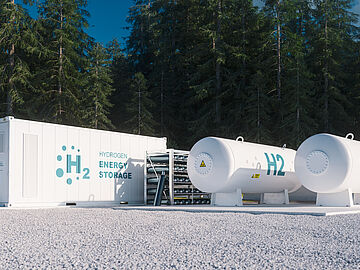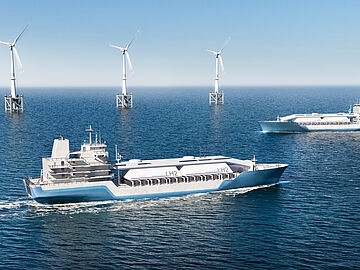Hydrogen as an energy storage solution in hybrid power plants
The backbone of future energy generation will be power plants utilizing renewable energy sources, primarily solar and wind power, or combinations thereof. So-called hybrid renewable power plants, also known as "Hybrid Power Plants," integrate electricity generation from renewable sources with storage systems to reconvert part of the electricity into hydrogen, potentially in combination with other storage technologies such as batteries. These power plants are expected to be increasingly developed in the future. They allow for the utilization of excess electricity, thereby enhancing the flexibility of the electricity system. Reconversion can occur through gas turbines in open or combined cycles or via fuel cells.
Hydrogen as a Fuel
Interest in using hydrogen as a fuel in the energy sector has grown in recent years. Globally, energy utilities are exploring and testing the co-firing of hydrogen with natural gas in combined or open gas turbines. Using hydrogen in the form of ammonia is another potential option for power generation, particularly in Asia, where ammonia co-firing in coal-fired power plants is being considered. In the short term, the use of hydrogen and ammonia can reduce emissions from existing power plants. In the long term, power plants operating solely on hydrogen or ammonia, combined with large-scale hydrogen storage, can enhance the flexibility of the electricity system.
Challenges in Hydrogen Infrastructure
Key challenges include higher production costs for low-emission hydrogen compared to hydrogen from fossil fuels, unclear regulations and certifications, and the lack of infrastructure for hydrogen transport and storage. This lack of infrastructure is a barrier to connecting regions where low-emission hydrogen can be produced cost-effectively with demand centers, managing fluctuations in production and demand, and ensuring system resilience in case of supply interruptions. In Europe, significant efforts are underway to address these challenges. European transmission system operators have launched the "European Hydrogen Backbone" initiative to advance hydrogen infrastructure development. Investments in hydrogen and hydrogen-based fuel transport infrastructure—such as pipelines, storage facilities, terminals, and refueling stations—need to be planned well in advance, as energy infrastructure projects typically have long lead times of several years.
The well-developed natural gas pipeline network, coupled with the anticipated decline in natural gas consumption, presents an excellent opportunity to repurpose existing infrastructure for hydrogen. This approach can significantly reduce investment costs, risks, and project lead times. Combined with new hydrogen pipelines, this infrastructure can connect various countries and even continents, providing the system with a degree of flexibility.
Hydrogen Storage for Energy Supply
Large-scale hydrogen storage in underground facilities will become necessary to account for seasonal fluctuations in renewable energy generation and enhance energy security, especially in light of potential import dependencies. Hydrogen storage facilities capable of undergoing multiple cycles within a year may be required. Depending on geological availability, options include salt cavern storage, lined hard rock cavern storage, or porous reservoirs.
Hydrogen Transport and Energy Logistics
For long-distance hydrogen transport where pipelines are not feasible or in regions lacking suitable geological conditions for underground storage, hydrogen must be compressed. Promising alternatives include liquefied hydrogen (LH₂) and carriers such as ammonia or liquid organic hydrogen carriers (LOHCs). While the conversion of hydrogen into ammonia for use as ammonia is already well-established, the necessary technologies for reconverting ammonia back into hydrogen are not yet commercially available at scale. This represents a key area for further technological development.





